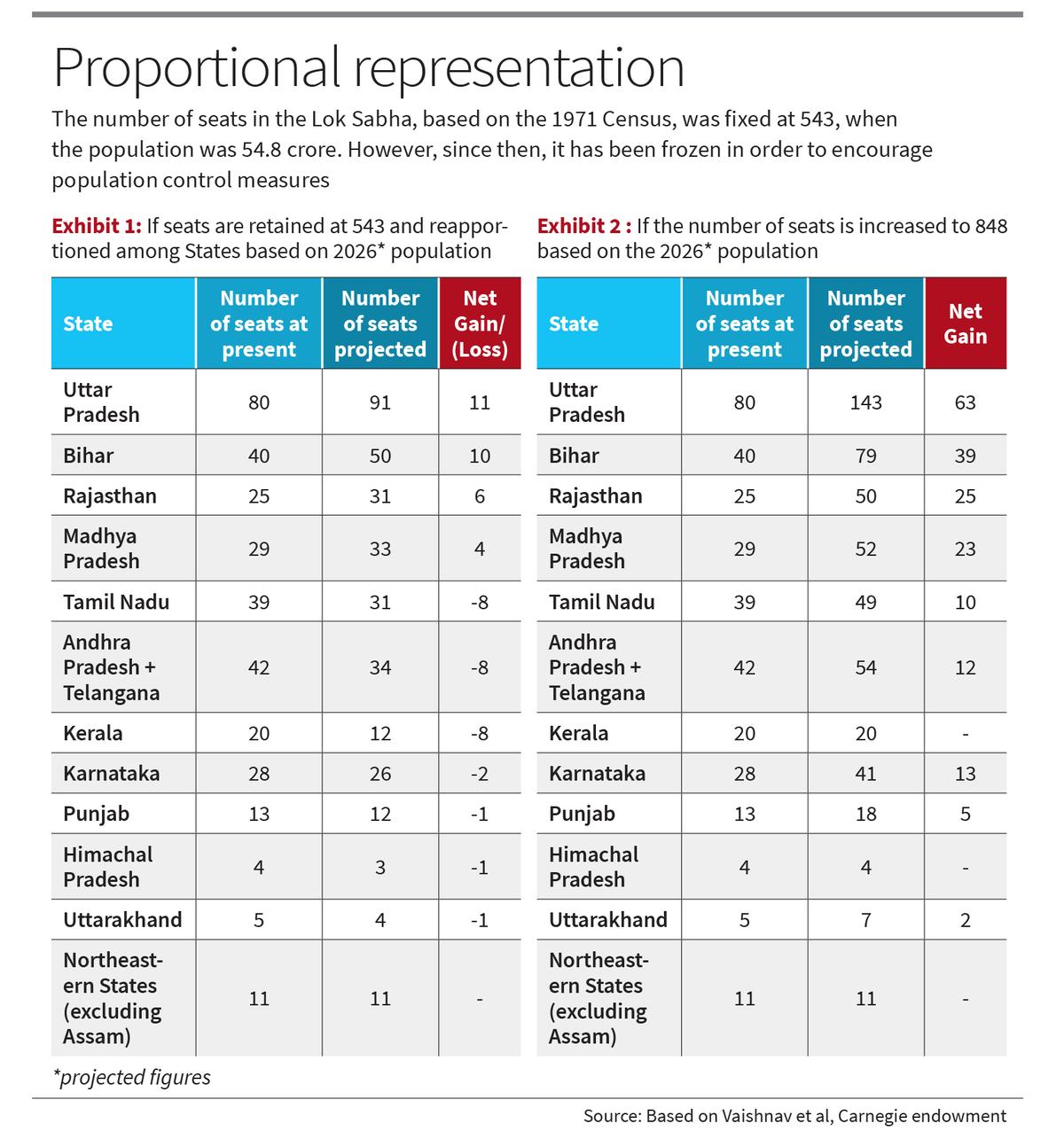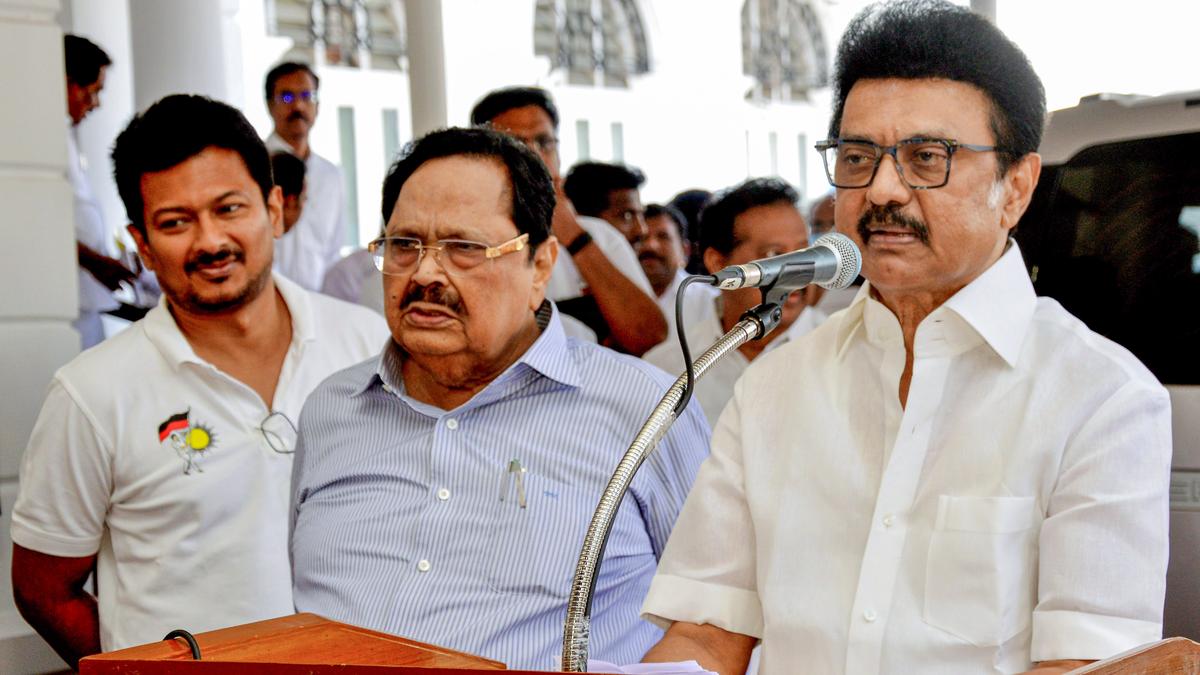Tamil Nadu Chief Minister M.K. Stalin speaks to the media on delimitation, in Chennai on February 25.
| Photo Credit: ANI
The story so far: There has been a renewed debate about delimitation after the issue was raised by the Chief Minister of Tamil Nadu. The delimitation of constituencies for the Lok Sabha and State Legislative Assemblies is to be carried out on the basis of the first Census after 2026.
What are constitutional provisions?
Delimitation means the process of fixing the number of seats and boundaries of territorial constituencies in each State for the Lok Sabha and Legislative assemblies. This exercise is performed by the ‘Delimitation Commission’ that is set up by an act of Parliament. Such an exercise was carried out based on the 1951, 1961 and 1971 Census. The number of seats in the Lok Sabha, based on the 1971 Census, was fixed at 543, when the population was 54.8 crore. However, since then, it has been frozen in order to encourage population control measures. This number is to be readjusted based on the first Census after 2026. As the 2021 Census that was originally postponed due to COVID-19 is yet to commence, there have been debates linking it to the ensuing delimitation.
What are the issues?
The population explosion that happened in our country during the last five decades has been uneven with some States like Uttar Pradesh, Bihar, Madhya Pradesh and Rajasthan having a greater increase than States like Kerala, Tamil Nadu, Karnataka and Andhra Pradesh. There are two scenarios that are being discussed with respect to the revised delimitation exercise.
The first is to continue with the existing 543 seats and their redistribution amongst various States (Exhibit 1). The second is to increase the number of seats to 848, with proportionate increase among various States (Exhibit 2). Home Minister Amit Shah stated in a recent public meeting that the number of seats will not be reduced for any State and that it would be increased on a ‘pro-rata’ basis for all States including the southern States. The basis for this ‘pro-rata’ share for States — whether it will be based on the existing percentage in the share of seats or on projected population — is not clear.

As per Exhibit 2 which is based on projected population, it is evident that southern States, smaller States in the north like Punjab, Himachal Pradesh and Uttarakhand, as well as the northeastern States are bound to be at a disadvantage when compared to the larger northern States. This may go against the ‘basic structure’ of federalism in our polity. It will lead to a feeling of disenchantment in the States that stand to lose in their proportional representation, and thereby political significance, despite controlling their population.
Southern States that have a 24% share in the number of seats at present would see it decline by 5%.
What can be a solution?
‘Democracy’ means ‘rule or government by the people’. It follows that the government is elected by the majority with the broad principle of ‘one citizen-one vote-one value’. However, it is pertinent to note that this principle has been diluted, in the interest of population control, since 1976 when the delimitation exercise was postponed for the first time.
In a federation like the U.S., the number of seats in the House of Representatives has been capped at 435 since 1913, though the population of the country has increased almost four times from 9.4 crore in 1911 to an estimated 34 crore in 2024.
The main job of a Member of Parliament (MP) is to legislate on ‘Union List’ matters and hold the Union government accountable. Majority of the schemes of the Union Government are implemented by State governments. The country has functioned with 543 Lok Sabha MPs for the past five decades while the population increased from 55 crore to 145 crore. India’s population is projected to peak at around 165-170 crore, an increase of around 15% from the current level, in the next three decades and then decline. Considering the above factors, the 543 MPs in Lok Sabha may be capped at the existing number. It would ensure status quo in representation from various States and uphold the federal principle. The MPs and leaders of both regional and national political parties from the south, smaller States in north and the northeastern States should consider it their responsibility to demand such a cap from the Parliament in order to protect the political interest of the regions they represent. The number of MLAs in each State may be increased in line with the projected population to address the democratic representational requirement.
Rangarajan R is a former IAS officer and author of ‘Polity Simplified’. He currently trains civil-service aspirants at ‘Officers IAS Academy’. Views expressed are personal.
Published – March 05, 2025 08:30 am IST
